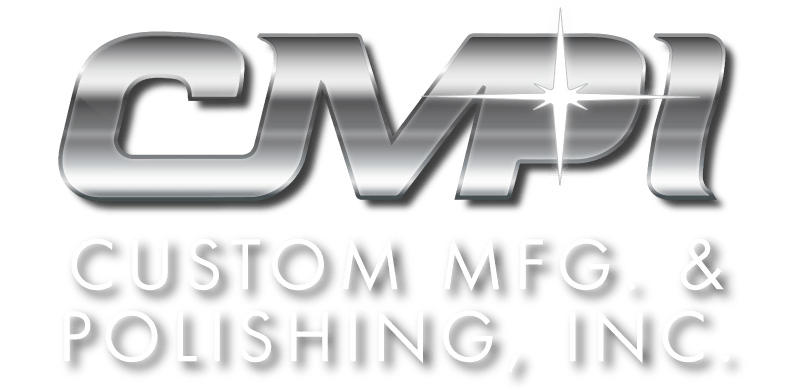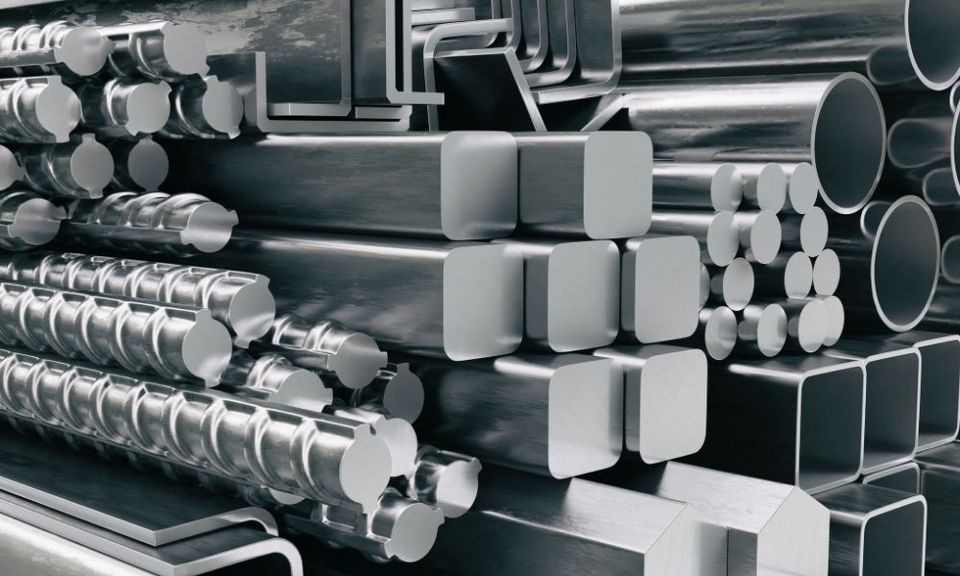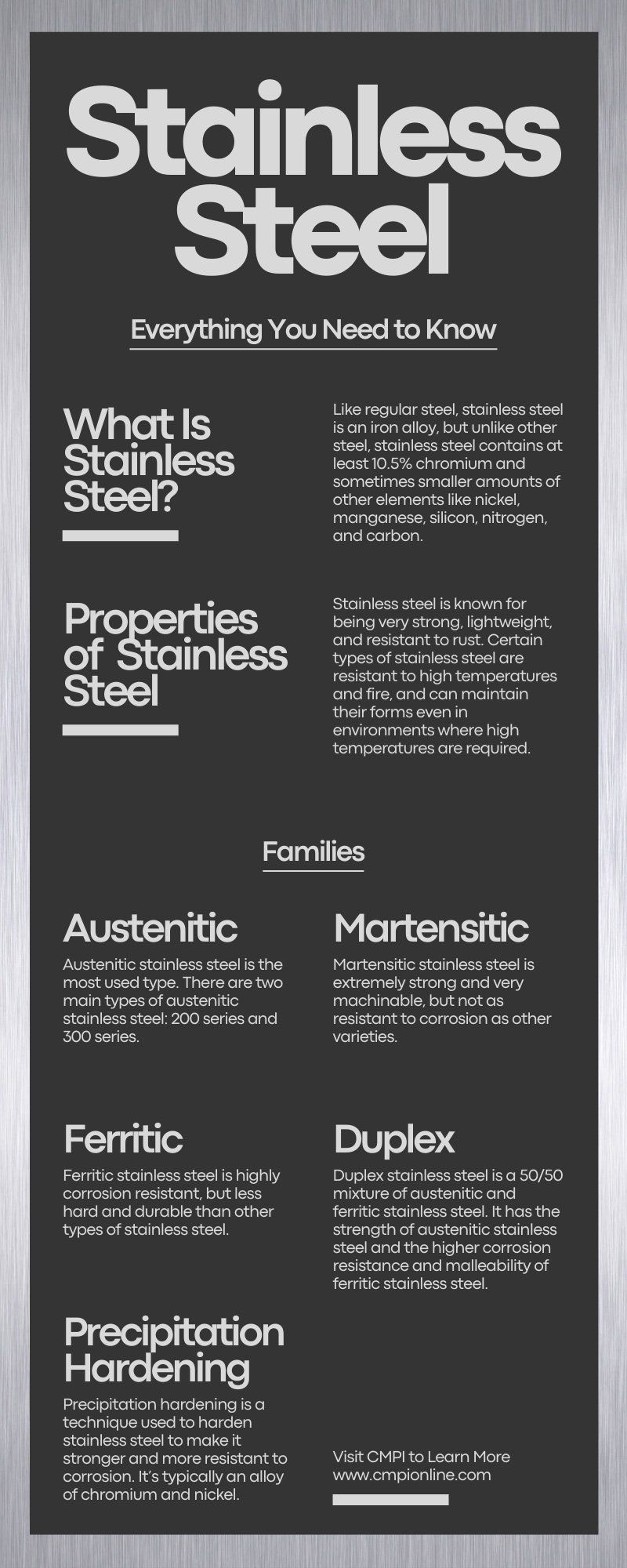Stainless Steel: Everything You Need To Know
Stainless steel is one of the most versatile types of materials, valued across industries for its many different functions and benefits. But despite its ubiquitous nature, many people still don’t know all that much about the properties, uses, and specifications of different kinds of stainless steel. Have you ever wondered what the difference is between the gauge and grade of stainless steel, or how to choose the best type for your application? This guide will teach you everything you need to know about stainless steel .
What Is Stainless Steel?
First things first—what is stainless steel? Like regular steel, stainless steel is an iron alloy, but unlike other steel, stainless steel contains at least 10.5% chromium and sometimes smaller amounts of other elements like nickel, manganese, silicon, nitrogen, and carbon. The addition of chromium to stainless steel is very important, as chromium is what give stainless steel its rust-resistant quality—chromium forms a protective barrier on the surface of the steel, protecting it from elements like oxygen that would cause it to rust.
Properties of Stainless Steel
Stainless steel is known for being very strong, lightweight, and resistant to rust. Certain types of stainless steel are resistant to high temperatures and fire and can maintain their forms even in environments where high temperatures are required. It’s also non-porous, making it an easy-to-clean, hygienic material. Stainless steel can easily be welded into a variety of different shapes and objects to fit the needs of the various industries in which it’s used.
Types of Stainless Steel
Because stainless steel is an alloy, there are numerous types. A type of stainless steel’s classification depends upon what percentage of each element comprises the stainless steel. Stainless steel is first classified into one of five family groups, then further classified within each family group by grade. Below, we’ll explain the five stainless steel families.
Families
Austenitic
Austenitic stainless steel is the most used type. There are two main types of austenitic stainless steel: 200 series and 300 series. 200 Series austenitic stainless steel is composed of chromium, carbon, manganese, and nickel. 300 series austenitic stainless steel is made of chromium, nickel, and iron. Both varieties are very hard, durable, and corrosion resistant due to the higher percentage of chromium in the alloy.
Martensitic
Martensitic stainless steel is extremely strong and very machinable, but not as resistant to corrosion as other varieties. It contains carbon, chromium, and iron and is harder to form than other types of stainless steel.
Ferritic
Ferritic stainless steel is highly corrosion resistant, but less hard and durable than other types of stainless steel. It contains a high amount of chromium and very little nickel or carbon. It’s easier to engineer than other types of stainless steel and has magnetic qualities.
Duplex
Duplex stainless steel is a 50/50 mixture of austenitic and ferritic stainless steel. It has the strength of austenitic stainless steel and the higher corrosion resistance and malleability of ferritic stainless steel.
Precipitation Hardening
Precipitation hardening is a technique used to harden stainless steel to make it stronger and more resistant to corrosion. It’s typically an alloy of chromium and nickel.
Grades
Within each family category of stainless steel, different types of stainless steel are classified by grade. Depending on how tough, malleable, magnetic, or corrosion-resistant you want your stainless steel to be, you’ll need to choose between different grades with different compositions and qualities. Stainless steel grades typically fall into the 200, 300, or 400 series categories. The most used grade of stainless steel is 304, which is made of chromium and nickel and used in many industries, including industrial, medical, food, and just about any other industry. The second most common type, 316, is similar to 304 but has added molybdenum, which increases the metal’s resistance to corrosion.
Gauges
In addition to the many different grades of stainless steel, there are many different gauges. Stainless steel gauge is the thickness of the metal. On the scale of measurement for gauges, a higher number means a thinner sheet of metal, while a lower number indicates a thicker sheet. Due to the differing functions of stainless-steel products and tools, a buyer might need to purchase different gauges of stainless steel for different applications.
Finishes
If you take a look at the stainless steel around you, you’ll probably notice that it doesn’t all look exactly the same. This is because stainless comes in different finishes which impact the smoothness, shininess, grain, and appearance of the surface. Some popular stainless-steel finishes include:
- 2B – A cold rolled finish, often referred to as “Mill,” with a matte, slightly reflective surface. Often used in applications where appearance is not the top priority.
- No. 3 – A lightly polished surface with a clear, visible grain running in one direction.
- No. 4 – A brushed finish with a visible grain resulting in a slightly reflective surface. Easy to maintain and often used in kitchen, medical, and architectural applications.
- No. 8 – A highly polished, mirror-like surface resulting from polishing with fine abrasives. No grain is visible and it’s typically used for cosmetic purposes.
Uses of Stainless Steel
The possible uses of stainless steel are basically endless! Many industries have the need for a strong, corrosion-resistant material that is also attractive in appearance. Here’s a look at some of the industries in which stainless steel is popular.
Kitchen, Food, and Beverage Industries
In kitchen, food, and beverage related industries, it’s important for equipment to be kept clean and sterile. Stainless steel allows for easy cleaning and sanitization as well as durability in regularly used equipment.
Medical and Pharmaceutical Industries
Like food related industries, medical and pharmaceutical industries prioritize sterile environments. The non-porous nature of stainless steel and its resistance to rust allows members of these industries to sterilize equipment easily, keeping patients and clients healthy.
Automotive Industry
Stainless steel is often used in the construction of cars and other vehicles. A vehicle’s parts must be able to withstand climate, weather, and high temperatures without becoming damaged. Because it’s sturdy and can handle all three, stainless steel is a good material choice in this industry.
Architectural Industry
Stainless steel is also used in the architectural industry for both structural and decorative elements. Stainless steel beams, pipes, handrails, and other architectural materials are readily available from stainless steel fabricators.
There you have it— everything you need to know about stainless steel in one brief article. If you’ve realized that stainless steel is the material you’ve been missing in your industry or project, contact CMPI about our custom stainless steel fabrication. We can help you create the perfect customized pieces in a variety of grades, gauges, and finishes. You dream it, we build it!





